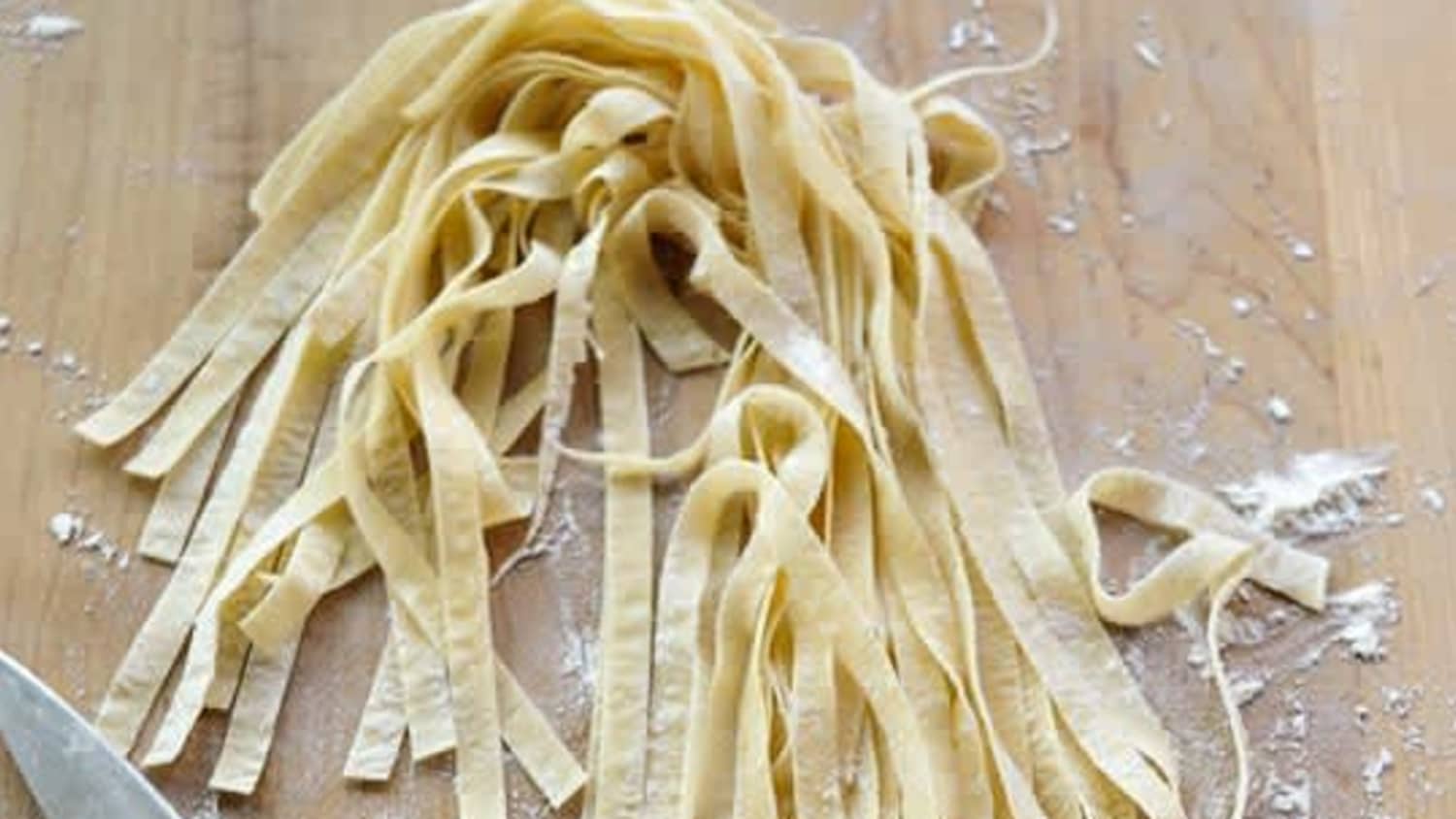Fresh Egg Pasta
3.9
(28)
Your folders
Your folders
Servings: 5
Cost: $1.93 /serving
Author : Emma Christensen

Ingredients
Export 2 ingredients for grocery delivery
Instructions
Step 1
Combine the Flour and Salt: Whisk together the flour and salt with a fork in a medium mixing bowl.
Step 2
Add the Eggs: Create a deep well in the middle of the flour and crack the eggs into this well. Whisk the eggs with the fork to combine.Note: You can do this on the counter-top "Italian Grandmother Style" if you prefer, but I find it's easier and less messy to do it in a bowl. For food-processor instructions, see below.
Step 3
Begin Combining the Flour and Eggs: As you whisk the eggs, begin gradually pulling in flour from the bottom and sides of the bowl. Don't rush this step. At first, the eggs will start to look like a slurry. Once enough flour has been added, it will start forming a very soft dough. Don't worry if you haven't used all the flour.
Step 4
Knead the Pasta Dough: Turn the dough and any excess flour out onto a clean counter. Begin gently folding the dough on itself, flattening, and folding again. It will be extremely soft at first, then gradually start to firm up. Once it's firm enough to knead, begin kneading the dough. Incorporate more flour as needed to prevent the dough from sticking to you or the counter. Slice into the dough with a paring knife; if you see lots of air bubbles, keep kneading. The dough is kneaded when it forms a smooth elastic ball and has very few air bubbles when cut.
Step 5
Rest the Pasta Dough: Clean and dry the mixing bowl. Place the ball of dough inside and cover with a dinner plate or plastic wrap. Rest for at least 30 minutes.Note: At this point, the pasta dough can be refrigerated for up to 24 hours. Let it come back to room temperature before rolling.
Step 6
Divide the Pasta Dough: Sprinkle a baking sheet generously with flour and scrape the ball of dough on top (it will stick to the bowl; use a spatula or bowl scraper if necessary). Divide the dough into four equal portions. Dust the portions with flour and cover with a clean dishtowel.Note: The name of the game at this point is to keep everything well-floured to prevent the pasta from sticking to itself or the roller as you work. If the dough starts to feel sticky as you roll it, sprinkle it with flour. Also sprinkle flour on any pasta you're not working (rolled, cut or otherwise) with and keep it covered with a dishtowel.
Step 7
Begin Rolling Out the Pasta: Set your pasta machine to the thickest setting (usually marked "1"). Flatten one piece of dough into a thick disk between your hands and feed it through the pasta roller. Repeat once or twice. Fold this piece of dough into thirds, like folding a letter, and press it between your hands again. With the pasta machine still on the widest setting, feed the pasta crosswise between the rollers (see picture). Feed it through once or twice more until smooth. If desired, repeat this folding step. This helps to strengthen the gluten in the flour, giving it a chewier texture when cooked.
Step 8
Thin the Pasta: Begin changing the settings on your roller to roll the pasta thinner and thinner. Roll the pasta two or three times at each setting, and don't skip settings (the pasta tends to snag and warp if you do). If the pasta gets too long to be manageable, lay it on a cutting board and slice it in half. Roll the pasta as thin as you like to go. For linguine and fettuccine, I normally go to 6 or 7 on the KitchenAid attachement; for angel hair or stuffed pastas, I go one or two settings thinner.
Step 9
Cut the Pasta: Cut the long stretch of dough into noodle-length sheets, usually about 12-inches. If making filled pasta or lasagna, proceed with shaping. If cutting into noodles, switch from the pasta roller to the noodle cutter, and run the sheet of pasta through the cutter. Toss the noodles with a little flour to keep them from sticking and gather them into a loose basket. Set this basket on the floured baking sheet and cover with a towel while you finish rolling and cutting the rest of the dough.Note: I find it easiest to roll all the pasta at once before proceeding to cutting it into noodles. I sprinkle the sheets of pasta liberally with flour and overlap them on a floured baking sheet, covered with a towel.
Step 10
Cooking, Drying, or Freezing the Pasta: To cook the pasta immediately, bring a large pot of water to a boil, salt the water, and cook the pasta until al dente, 4-5 minutes. To dry, lay the pasta over a clothes drying rack, coat hangers, or the back of a chair, and let air dry until completely brittle. Store in an airtight container for several weeks. To freeze, either freeze flat in long noodles or in the basket-shape on a baking sheet until completely frozen. Gather into an airtight container and freeze for up to three months. Dried and frozen noodles may need an extra minute or two to cook.